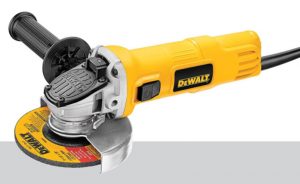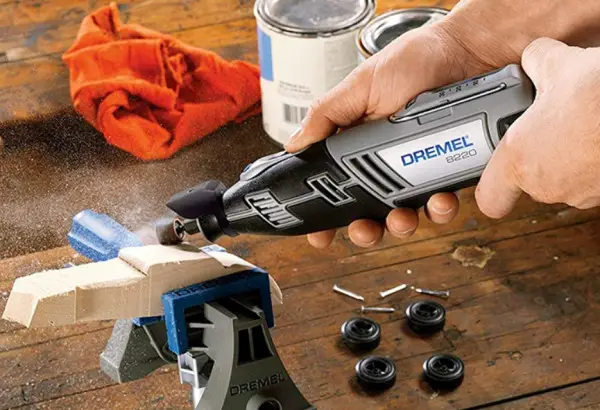Angle grinders vs Dremels are power tools used for cutting, sanding, polishing, and more. So, which tool is more suitable for your household work?
This article will go through the key similarities and differences between these two tools to help you pick up an option that means more for you.
Contents
An Overview Of Angle Grinders
An angle grinder is a power tool primarily used for heavy-duty projects. It is designed for two-handed operation with an attached disc or attachment. The disc/attachment type depends on your purpose of work.
This tool can cut hard materials like glass, metal, wood, stucco, tile. Besides, it can also be used for sanding or polishing metal or cleaning up and smoothing surfaces.

An Overview Of Dremel
Dremel is a manufacturer of versatile tools for construction sites and workshops (like Dremel ultra saw US40), and also the name of a rotary tool. A Dremel is a one-handed operation tool and can be used for light-duty jobs or jobs that need high precision.
Unlike a power drill, a Dremel utilizes its fast speeds bits with a base unit for cutting, polishing, drilling, sanding, carving glass and metal. You can use a Dremel for making pocket holes on a wooden surface or even in interactive calligraphy.

Angle Grinder Vs Dremel: Key Differences
Application
An angle grinder is mainly used for grinding metal. Besides, it can also be used for cutting, sharpening, chamfering, sanding, polishing, and deburring. You can also use this two-handed operation tool to remove rust, mortar, paint, clean and polish metal, or perform basic woodworking.
It can work on metal blades, metal sheets, welded joints, masonry, concrete, rebar, ceramic tile, stone, etc.
A Dremel can perform best on metal, wood, and glass. You can use this one-handed operation tool for fine-detailed work like carving, etching, engraving, or general mechanical jobs like cutting, grinding, sanding, polishing, and drilling.
Weight & Size
The tool’s weight and size are two critical factors when purchasing a power tool for extended use. So, Dremel vs angle grinder, which tool is more compact?
Medium and large angle grinders with a wheel size from 4.5 – 9 inches often have a weight from 3 to 12 pounds. On the other hand, small Dremels have a smaller wheel size from 15/16 to 1.5 inches and weight from 0.5 to 1.25 pounds.
Hence, angle grinders are heavier and bulkier than Dremels. Their bulky can cause fatigue to your arms and hands or discomfort if you handle it for an extended period.
Power source
These two handy tools offer two power source options – corded and cordless. But there is one small difference.
Corded angle grinders use electricity or air pressure, while corded Dremels only have one power supply option – electricity. When comparing power source and performance, angle grinders trump Dremels.
If you have to prioritize the compactness of a tool without scarifying its power, you should go for an angle grinder instead of a Dremel.
Cutting depth
If you seek a power tool to tackle jobs that require high precision or work on fragile materials (for example, wood carving), you should not neglect its cutting depth. The depth control of a power tool allows you to have batter cuts and minimize material loss.
While Dremels have depth control, angle grinders don’t. So, the latter is not recommended for these job types.

Speed
The speed of a power tool determines how fast it can get your job done and is calculated in RPM (revolutions per minute or rotations per minute).
Angle grinders have a speed range of 2,000-11,000 RPM, while Dremels can perform between 5,000 and 35,000 RPM. So Dremels have a broader speed limitation than angle grinders.
Complexity of use
Angle grinders require a two-handed operation, meaning that you have to hold the tool with your two hands to stay stable and safe when working at high speeds.
Conversely, rotary tools require a one-handed operation. You can hold a Dremel with your preferred hand (either your left or right hand).
Working material
Glass
Although angle grinders can cut or polish thick pieces of glass (for instance, glass tiles), they are not highly advisable to work on this fragile material. To cut glass with a grinder, you need to install a diamond blade and apply moisture to minimize glass debris.
Rotary tools like Dremels are excellent choices for glass working. You can use them to cut, polish, sand glass, or do detailed works like carve, etch, or engrave on glass surfaces. Like angle grinders, you need to use it with a special attachment like a diamond blade and apply moisture when working on glass.
Wood
Both these two power tools can work on wood but at different scales. So which tool should you choose for woodworking?
Angle grinders can do rough shaping, sanding edges, removing stock on wooden surfaces, or sharpening chisels and planer knives. However, they have large discs and lack the portability to perform high-precision work like sanding or shaping small pieces of wood.
Dremels have smaller blades, allowing them to handle cutting, drilling, shaping, sanding, carving, and engraving on wood with high precision. Yet, they will take more time to handle extensive wooden surfaces than the grinders.

Metal
While both these two tools can work on metal, their level of precision and area of working might vary.
Angle grinders are mainly used for cutting, grinding, deburring, polishing, chamfering, or sharpening hard metal. They can also be used to remove rust on old metal furniture in surface preparation. These two-handed tools can handle heavy-duty metal work like cutting rebar.
Dremels can perform fine cuts on hard metal like steel or engrave and etch on metal surfaces. They can sharpen blunt blades, grind metal edges, remove rust, or carve metal. However, cutting rebar with a Dremel is not advisable for any reason since it can quickly damage its motor.
Plastics
Angle grinders can cut PVC and IBC pipes, but the plastic can get hot and melt due to high friction. Consequently, the blade can get stuck, and the tool can stop working.
You should use Dremels with an appropriate wheel to work on plastic, provided that your tool does not exceed a maximum speed of 15,000 RPM. These tools can safely work on some kinds of plastic, like vinyl or plexiglass.
Attachments
An angle grinder can be compatible with discs or brushes:
- Discs: wire, dry-cut diamond, grinding, metal cutoff, and diamond tuckpointing discs.
- Brushes: wire cup brushes.
A Dremel has a broader choice of attachments, including flex shaft, multi-purpose cutting guide, circle cutter with a straight-edge guide, shaping platform, mower, and garden tool sharpener, shield, grinding, sharpening, engraving, and carving accessories.
Price
In general, a Dremel tool is far pricier than an angle grinder. If you have a tight budget, you should choose an angle grinder or find an affordable Dremel.
Dremel Or Angle Grinder: Which Tool Should You Choose?
The choice of tool depends on your working areas, working materials, level of precision, and your budget.
Choose an angle grinder if you often have to work on large surfaces (like removing rust or repainting cars), cut hard materials (like ceramic tile, concrete, or rebar). This robust handy tool doesn’t cost you much and can handle various tough jobs at home or work with fewer damages than a Dremel.
Choose a Dremel if you are a craftsman who often carves, etches, or engraves on stone, wood, or glass, or you have a lot of jobs in tiny areas that require high precision. A Dremel can sometimes serve as a universal tool as an angle grinder but at a smaller scale.
Read more: Die Grinder Vs Angle Grinder
FAQs (Related Questions)
1. Can I use a Dremel as an angle grinder?
A Dremel can sometimes be utilized as an angle grinder, but not all of the time. It works with smaller blades, taking longer to get a job done than a grinder.
Moreover, working on heavy-duty jobs with a Dremel can quickly wear out its motor.
2. Can you grind with a Dremel?
You can grind a small area with a Dremel. But if you have to work on a large-scale grinding project, you should choose an angle grinder to get your job done faster.
3. Can a Dremel cut welds?
A Dremel can’t cut welds. Instead, you should use a more powerful tool like an angle grinder to perform this work.
Check more: Angle Grinder Vs Reciprocating Saw: In-depth Comparison
Final Words
After reading the detailed comparison of angle grinders and Dremels, you have understood that angle grinders are more powerful and appropriate for large-scale projects. On the other hand, Dremels are more compact and lightweight, allowing them to tackle detailed work with high precision.
The choice of each tool depends on the requirements of each project. Knowing the key similarities and differences between these two tools will help you pick up a valuable tool for your upcoming work.
